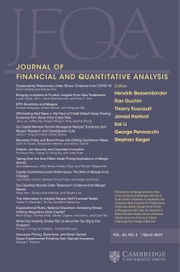No CrossRef data available.
Article contents
Leverage and Stablecoin Pegs
Published online by Cambridge University Press: 14 March 2025
Abstract
Stablecoins are a new form of private money. They are fragile but largely trade at par. How? We present a model and empirical work to examine a novel source of demand for stablecoins. Stablecoin owners are indirectly compensated for run risk by lending their coins to crypto speculators. The stablecoin can then support its $1 peg, but this arrangement links crypto speculation to traditional financial markets where stablecoins invest their reserves.
Information
- Type
- Research Article
- Information
- Creative Commons
- This is an Open Access article, distributed under the terms of the Creative Commons Attribution licence (http://creativecommons.org/licenses/by/4.0), which permits unrestricted re-use, distribution and reproduction, provided the original article is properly cited.
- Copyright
- © The Author(s), 2025. Published by Cambridge University Press on behalf of the Michael G. Foster School of Business, University of Washington
Footnotes
This article benefited greatly from comments and suggestions from George Pennacchi (the editor) and an anonymous reviewer. We thank Oliver Hyman-Metzger and Arazi Lubis for excellent research assistance. For comments and suggestions, thanks to Joseph Abadi, David Arseneau, Christoph Bertsch, Eduardo Davila, John Geanakoplos, Pedro Gomis Porqueras, Daniel Graves, Todd Keister, Michael Palumbo, Christine Parlour, Greg Phelan, David Rappoport, Thomas Rivera, Raluca Roman, Scott Schuh, Donghwa Shin, Alp Simsek, Antoinette Schoar, K. Sudhir, Dimitrios Tsomocos, Quentin Vandeweyer, Chris Waller, Sean Wilkoff, Russell Tsz-Nga Wong, and seminar and conference participants at the Office of Financial Research, the Fed Board 2022 Summer Workshop on Money, Banking, Payments, and Finance, the Fed System Committee on Financial Institutions, Regulation, and Markets, the Philadelphia Fed, the Fed Board FS workshop, the 2023 MFA, the 2023 Yale Cowles Conference on General Equilibrium, the OCC, the 2023 Edinburgh Economics of Financial Technology conference, the 2023 NASMES, the 2023 CEBRA, the 2023 Oxford Saïd-Risk Center at ETH Zürich Macro-Finance Conference, the 2023 MoFiR Workshop on Banking, the 2023 EFA, the 2023 Wharton Conference on Liquidity and Financial Fragility, the 2023 Economics of Payments Conference, Manhattan College, Banque de France/TSE/Pantheon ASSA, and 2024 SED. The views expressed in this article are those of the authors and do not necessarily represent those of Federal Reserve Board of Governors, or anyone in the Federal Reserve System.

